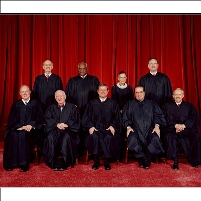The Case for Supreme Court Term Limits: Linda Greenhouse
Friday, May 29, 2009

Is this really what the Founding Fathers had in mind? Supreme Court justices remaining on the bench well into their golden years? Serving for a quarter of a century? Linda Greenhouse, a Pulitzer Prize-winning reporter for the New York Times, argues this is not what the framers of the Constitution wanted for the nation’s highest court, but it is nevertheless the situation that exists today.
Greenhouse points out that five current Supreme Court justices are 70 or older, and a sixth will turn 70 in a few months. Whereas justices used to serve an average of 15 years on the high court (from 1789 to 1970), they now stick around for an average of 26 years. This has resulted in fierce, partisan fights whenever a rare vacancy does occur. The infrequency of Supreme Court vacancies has left some presidents without the chance to appoint a single justice, such as Jimmy Carter. In fact, Democrats went 26 years without an appointment, from 1967 (when Thurgood Marshall was tabbed by President Lyndon Johnson) to 1993 (with President Bill Clinton’s selection of Ruth Bader Ginsburg).
All too often justices have remained on the bench even while seriously ill, such as former Chief Justice William Rehnquist. This does the court no good, and only adds to the reason why some kind of term limit needs to be imposed on Supreme Court justices, argues Greenhouse. Her recommendation is to allow each president to appoint two justices during each four-year term and limit these new appointees to a service of 18 years. Those already on the high court would be grandfathered in and wouldn’t have to step down until their choosing.
Greenhouse recognizes that her plan would enlarge the size of the court. To keep things manageable, not all the justices would be active members of the Supreme Court. Just as it is now, only nine would hold court, with all remaining justices serving as senior members who would fill in during vacancies, or if an active justice was sick or needed to recuse themselves from a particular case. These senior justices could also serve on federal appeals courts, as Sandra Day O'Connor has done during her retirement.
-Noel Brinkerhoff
The Case for Term Limits on the Supreme Court (by Linda Greenhouse, Yale Political Union)
- Top Stories
- Unusual News
- Where is the Money Going?
- Controversies
- U.S. and the World
- Appointments and Resignations
- Latest News
- Musk and Trump Fire Members of Congress
- Trump Calls for Violent Street Demonstrations Against Himself
- Trump Changes Name of Republican Party
- The 2024 Election By the Numbers
- Bashar al-Assad—The Fall of a Rabid AntiSemite






Comments